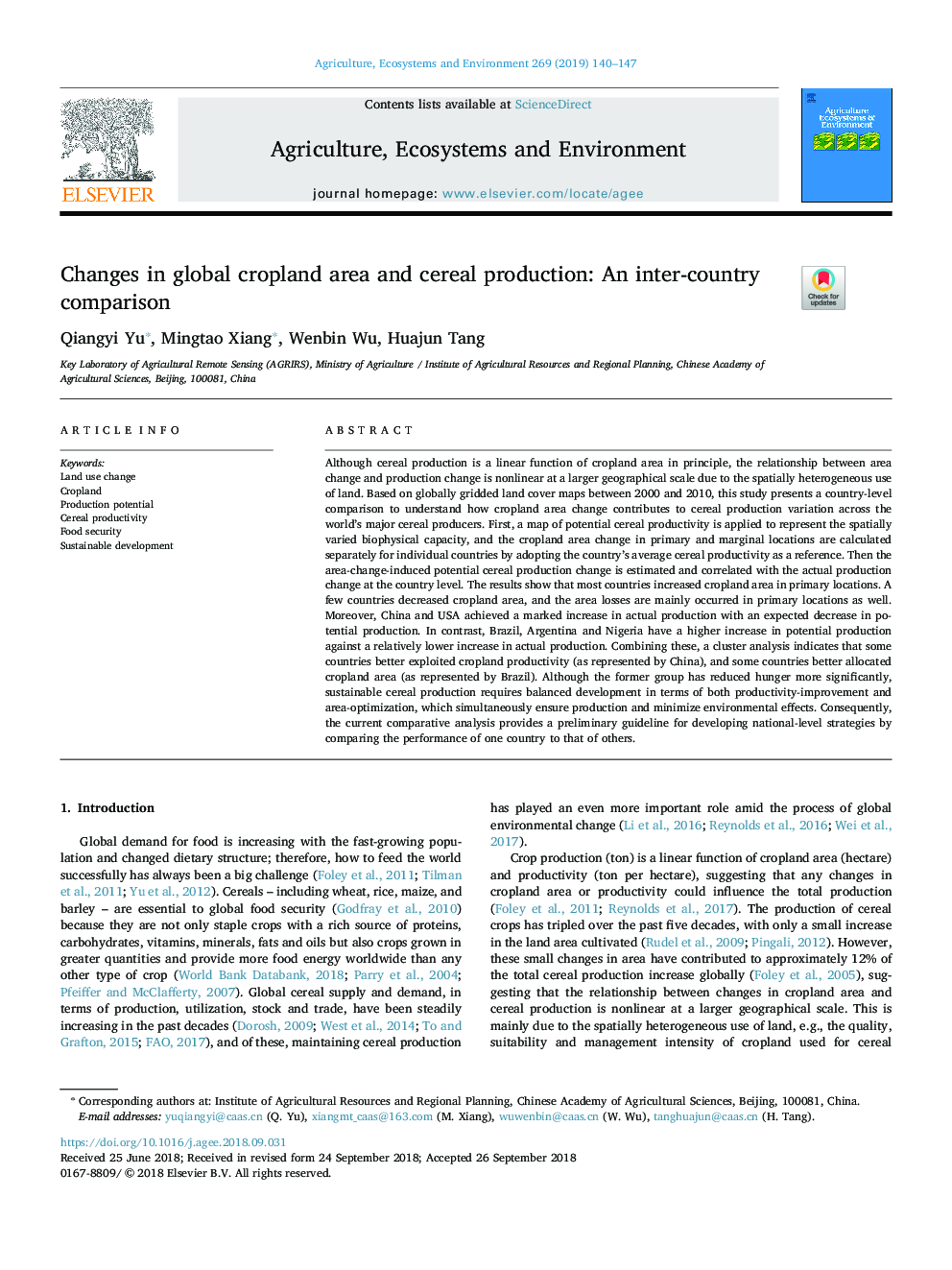| کد مقاله | کد نشریه | سال انتشار | مقاله انگلیسی | نسخه تمام متن |
|---|---|---|---|---|
| 11001824 | 1104192 | 2019 | 8 صفحه PDF | دانلود رایگان |
عنوان انگلیسی مقاله ISI
Changes in global cropland area and cereal production: An inter-country comparison
ترجمه فارسی عنوان
تغییرات در منطقه زمین کشاورزی و تولید غلات: مقایسه بین کشورها
دانلود مقاله + سفارش ترجمه
دانلود مقاله ISI انگلیسی
رایگان برای ایرانیان
کلمات کلیدی
تغییر کاربری زمین، باغچه پتانسیل تولید، بهره وری غلات، امنیت غذایی، توسعه پایدار،
ترجمه چکیده
اگر چه تولید غلات یک عملکرد خطی در حوزه کشاورزی است، اما رابطه تغییر منطقه و تغییر تولید در مقیاس جغرافیایی بزرگتر به علت استفاده ناهمگون از زمین، غیر خطی است. براساس نقشه های زمین پوشش جهانی در بین سال های 2000 تا 2010، این مطالعه یک مقایسه در سطح کشور را ارائه می دهد تا بدانند که چگونه تغییرات حوزه کشاورزی به تغییرات تولید غلات در سرتاسر تولید کنندگان غلات عمده جهان کمک می کند. اول، یک نقشه از بهره وری بالقوه غلات برای نشان دادن ظرفیت بیوفیزیکی متنوع متنوع استفاده می شود و تغییرات منطقه گیاهخواری در مکان های اولیه و حاشیه به طور جداگانه برای کشور های مختلف با استفاده از میانگین بهره وری غلات کشور به عنوان مرجع محاسبه می شود. سپس تغییر تولید غله با تغییر ناحیه تغییر محدوده، برآورد شده و با تغییرات واقعی تولید در سطح کشور ارتباط دارد. نتایج نشان می دهد که اکثر کشورها زمین های کشاورزی را در مکان های اولیه افزایش داده اند. تعداد کمی از کشورها زمین های کشاورزی را کاهش دادند و زیان های منطقه به طور عمده در مکان های اولیه نیز رخ داده است. علاوه بر این، چین و آمریکا به افزایش قابل توجهی در تولید واقعی با کاهش انتظارات تولید بالقوه دست یافتند. برعکس، برزیل، آرژانتین و نیجریه تولید بالقوه را در مقایسه با افزایش نسبتا پایین تولید واقعی افزایش می دهند. ترکیب اینها، تجزیه و تحلیل خوشه ای نشان می دهد که برخی از کشورها بهتر از بهره وری گیاهچه (به عنوان نمایندگی چین) بهره برداری می کنند، و بعضی از کشورها بهتر از آنکه زمین های کشاورزی را به خود اختصاص دهند (همانطور که توسط برزیل نمایندگی می شود). گرچه گروه سابق گرسنگی را به میزان قابل توجهی کاهش می دهد، تولید غلات پایدار نیازمند توسعه متعادل از لحاظ بهبود بهره وری و بهینه سازی منطقه است که همزمان تولید را تضمین می کند و اثرات زیست محیطی را کاهش می دهد. در نتیجه، تجزیه و تحلیل تطبیقی کنونی، یک راهبرد مقدماتی برای توسعه راهبردهای ملی را با مقایسه عملکرد یک کشور با دیگران فراهم می کند.
موضوعات مرتبط
علوم زیستی و بیوفناوری
علوم کشاورزی و بیولوژیک
علوم زراعت و اصلاح نباتات
چکیده انگلیسی
Although cereal production is a linear function of cropland area in principle, the relationship between area change and production change is nonlinear at a larger geographical scale due to the spatially heterogeneous use of land. Based on globally gridded land cover maps between 2000 and 2010, this study presents a country-level comparison to understand how cropland area change contributes to cereal production variation across the world's major cereal producers. First, a map of potential cereal productivity is applied to represent the spatially varied biophysical capacity, and the cropland area change in primary and marginal locations are calculated separately for individual countries by adopting the country's average cereal productivity as a reference. Then the area-change-induced potential cereal production change is estimated and correlated with the actual production change at the country level. The results show that most countries increased cropland area in primary locations. A few countries decreased cropland area, and the area losses are mainly occurred in primary locations as well. Moreover, China and USA achieved a marked increase in actual production with an expected decrease in potential production. In contrast, Brazil, Argentina and Nigeria have a higher increase in potential production against a relatively lower increase in actual production. Combining these, a cluster analysis indicates that some countries better exploited cropland productivity (as represented by China), and some countries better allocated cropland area (as represented by Brazil). Although the former group has reduced hunger more significantly, sustainable cereal production requires balanced development in terms of both productivity-improvement and area-optimization, which simultaneously ensure production and minimize environmental effects. Consequently, the current comparative analysis provides a preliminary guideline for developing national-level strategies by comparing the performance of one country to that of others.
ناشر
Database: Elsevier - ScienceDirect (ساینس دایرکت)
Journal: Agriculture, Ecosystems & Environment - Volume 269, 1 January 2019, Pages 140-147
Journal: Agriculture, Ecosystems & Environment - Volume 269, 1 January 2019, Pages 140-147
نویسندگان
Qiangyi Yu, Mingtao Xiang, Wenbin Wu, Huajun Tang,
